Of Shoeburyness in Essex
My Grandmother
©Compiled by Michael Russell FIPD March 2016
Link to House of CHRISTOPHER Master File
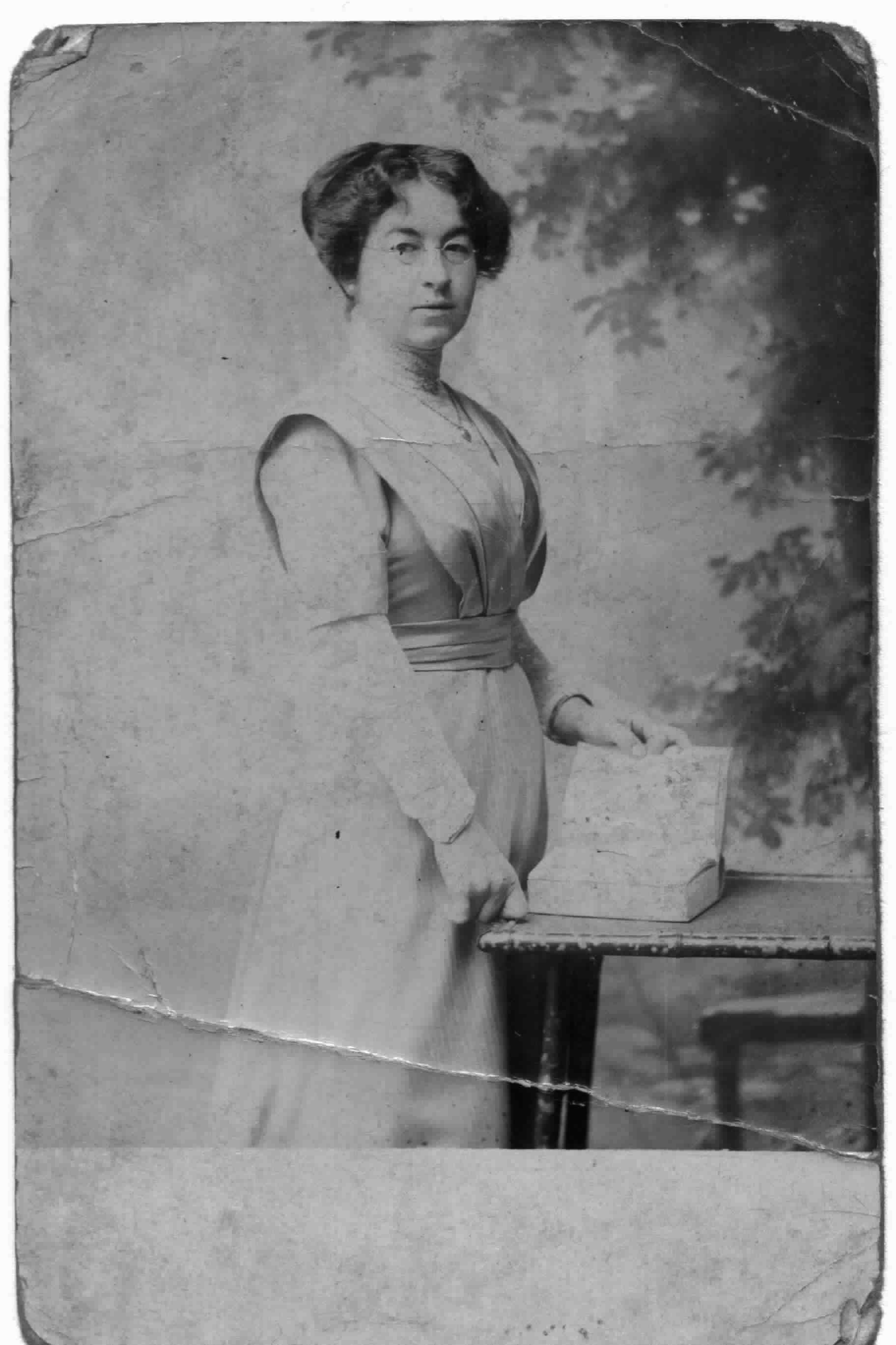
Emily Bertha CHRISTOPHER (1859-1916)
Circa 1910 Aged 22
©Picture Michael Russell FIPD 1972

Emily was my grandmother and first saw the light of day on 12th March 1888 when she was born at 69 Sandal Street in West Ham. 'Sandal Street' is still there and can be found on modern day maps situated between Stratford High Street and Abbey Road stations on the DLR Railway and is accessed from Arthingworth Street (1). Later that year her father was offered the post of 'signal fitter' by the Great Eastern Railway (G.E.R.) at Wickford Junction a new railway station being built in Essex (some background has already been given in her father's biography). The real attraction, apart from higher wages, was that it came with significantly better accommodation for his family. .jpg)
Wickford: The above map dating from 1897 shows the impact that the arrival of the Railways had on such a small remote agricultural village as Wickford. The excavations and embankments were significant and sliced right through the surrounding fields before cutting Wickford High Street in two, leaving the old 'Castle Inn' to the north, and the 'Congregational Chapel' to the south of the line. To allow traffic to continue to flow unaffected along the High Street the Railway passed overhead by means a bridge before dividing into the line heading north east to Woodham Ferris and that heading south east to Rayleigh and on to Southend. The new station was erected just north of the High Street. The road out of Wickford heading east is now the A129 to Southend and still passes under this bridge before heading out West past Bridge House. Wickford Junction Station officially opened for goods traffic on November 19th 1888 and the opening for passenger traffic was marked by a celebration at the Castle Inn on 1st Jan 1889 which was attended by her father. They lived in the 'Railway Cottages' built and owned by the company and used for it's station employees. They can just be seen nestled between the fork of the dividing line - bottom right of the map. Cottages probably gives the wrong impression today as they were in fact quite large semi detached houses situated in Wick Lane. The first picture below is taken just after the bridge over the line to Woodham Ferris, and shows the cottages on the right hand side behind the white picket fence, with the road leading to the level crossing over the Rayleigh line. 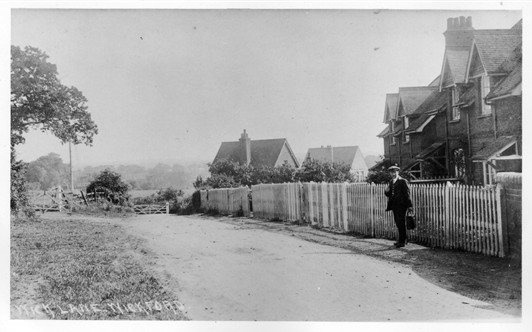 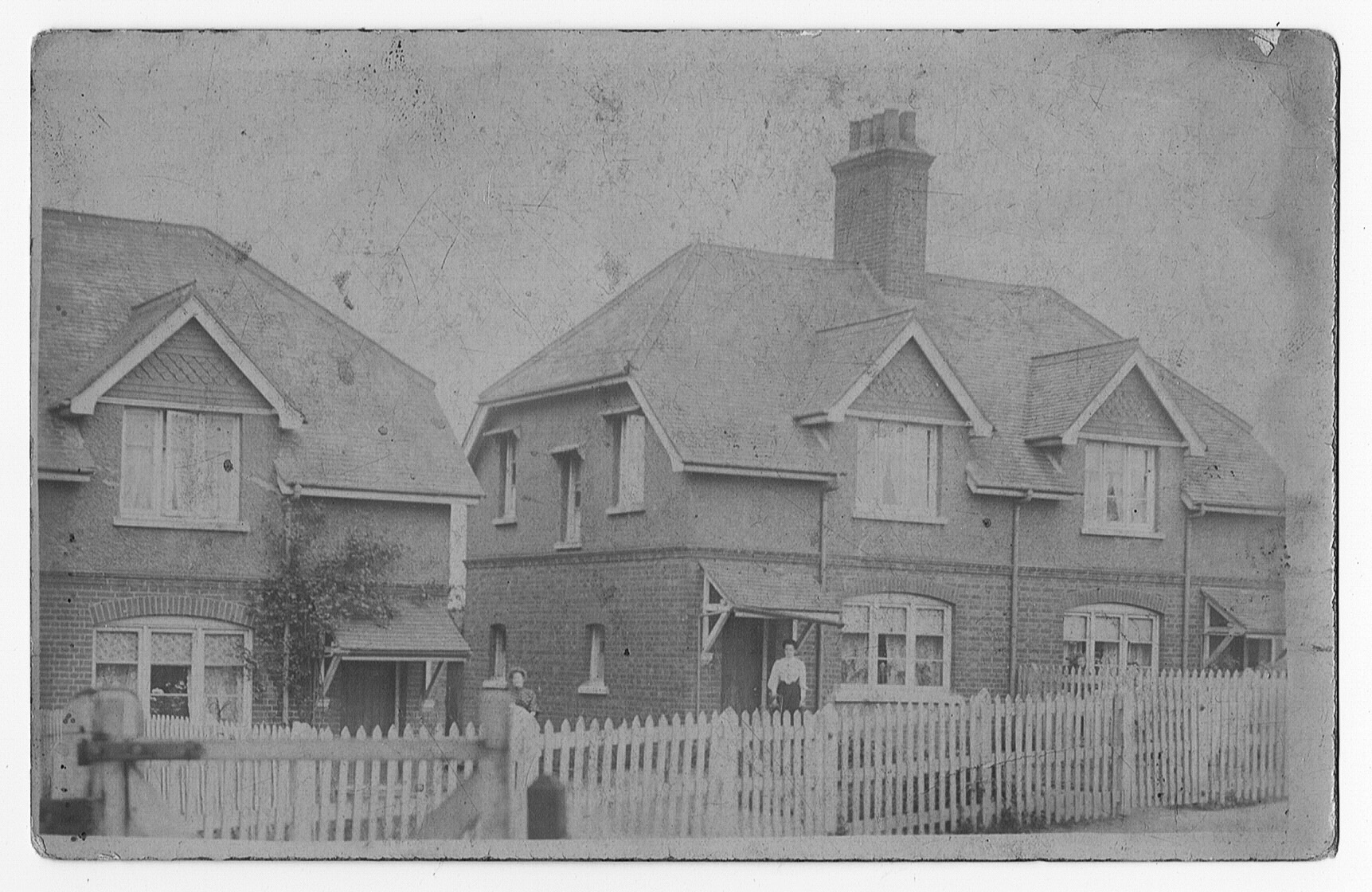 Living in the cottages on 1st Jan 1889 were Arthur and Catherine with their three surviving girls, Emily Bertha my grandmother (aged 9 months) and her two elder sisters, Florence Lizzie (aged 5 years and 1 month) and Lilian Katherine (aged 3 years and 8 months). The picture on the right was taken by Arthur showing how big these semi-detached properties were. Living in the cottages on 1st Jan 1889 were Arthur and Catherine with their three surviving girls, Emily Bertha my grandmother (aged 9 months) and her two elder sisters, Florence Lizzie (aged 5 years and 1 month) and Lilian Katherine (aged 3 years and 8 months). The picture on the right was taken by Arthur showing how big these semi-detached properties were. They lived in the house on the left with the rose bush growing over the porch. The level crossing gate can be seen in the foreground. I can remember my grandmother saying that by the time they left in 1916 the rose bush was glorious reaching all the way to the gutter and spreading half way across the window. It proved to be a very happy place to raise their family, with Arthur William Harry her younger brother being born there just after Christmas 1889, followed by Frederick Joseph in 1891, Minnie Amelia in 1894 and finally Robert George James in 1899. There are many great pictures of old Wickford on the Wickford History website which is highly recommended. This a very large site so it's worth spending time going through them. Some examples:- more views of Wick Lane level crossing ; Wick Lane circa 1910 ; It's important to realise that formal education as we know it today is a relatively recent phenomenon. Many churches of course ran Sunday Schools, and some towns and villages made provision for a rudimentary education but these benefited the fortunate rather than the masses. It was only with the passing of the 1870 Education Act that any meaningful attempt was made to introduce Elementary Education for everyone between the ages of 5 and 13. In 1861 a National School was built in Wickford at the site of the present Church of England School on the Southend Road where it is met by the northern end of Wick Lane. (2) Compulsory attendance did not arrive until 1880 and it was not free until 1891. So immediately they arrived Florence Lizzie went to the National School as she was already 5 years old. Her younger sister Lilian joined in 1890 followed by my grandmother in 1893. The April 1891 Census shows the 2 older sisters recorded as 'scholars' but also reveals that the Mistress in charge of the School House was the 45 year old spinster Miss Elizabeth Lovell. In those days it was common practice for a single teacher to supervise large classes assisted by monitors who were usually drawn from the older children. The monitors tended to look after and give some instruction to the younger children whilst the teacher set work for older children. In this case Miss Lovell had the help of Florence Waterman a native of Rochford who was just 14. When Emily was 9 years old great excitement occurred in the family. Her sister Florence who was 13 had reached the end of her education and they found her a job working as a nursemaid at 'The Beeches' a farm and cottage at the end of Wick Lane just across from the school. The farm of 238 acres was originally owned by Thomas Bell a well known figure in the local community who had actually made a contribution towards the cost of building the school. Thomas however died in April 1895 and it passed into new hands. I think the farm was bought by Henry Lester and his wife Ellen who had a young daughter Emmeline who aged 5 needed to attend school, and a 1 year old son named Henry. I think they employed Florence to look after the two children and their growing family. They have 4 children by the time of the 1901 census. One of her jobs would have been to walk and fetch Emmeline from school, probably with Henry in the pram. At midday on Wednesday 12th May 1897 several bags containing children's dinners were stolen out of the school porch. Suspicion fell upon 5 men who had been 'loafing about the neighbourhood' who were pursued by the local constable Pc. Peters and with the help off the constable at Billericay arrested them. I only know of this incident as they appeared before the magistrate at Brentwood when the school master a Mr William John Sully, Mr Henry Lester a local farmer and Florence Lizzie Christopher were called to give evidence. Religion: Emily was greatly influenced by her mother, Catherine Lucy Denman, when she was young. Catherine was a typical rather stern Victorian mother who habitually dressed in black and made sure the family attended church every week. She was a staunch Methodist, even before her marriage in the United Free Methodist Church in West Ham in 1881, and kept the faith until she died in 1935. 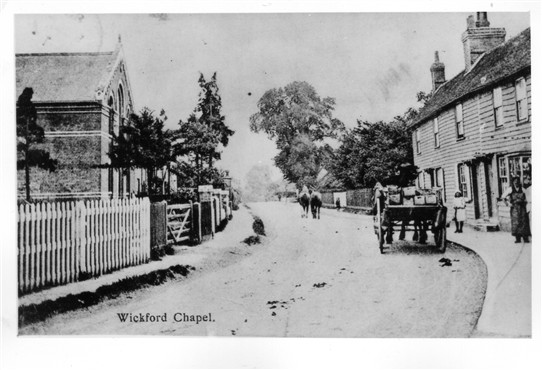 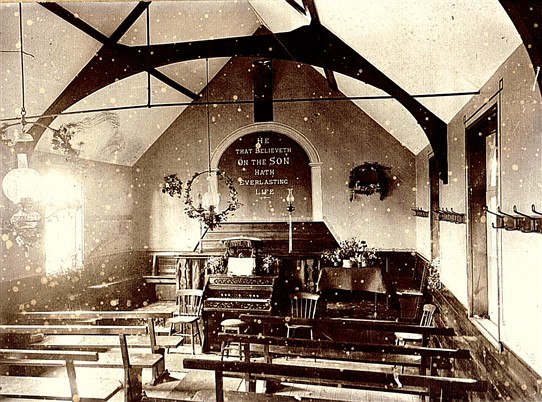 The problem they faced on arrival at Wickford was that there was no Methodist church available (3), so they appear to have become members of the Congregational Chapel in the High Street where her father was later to be buried. It was situated just opposite Market Road turnoff and is shown in the picture left just after the picket fence. With Religion playing such an important part in their lives, it is not surprising to find that Emily Bertha also embraced the faith with a fervour and even joined the Salvation Army Mission at Wickford when she was about seventeen. The picture right is of their hall and shows what it was like when Emily attended there in the early 1900's. The location of the Hall can be seen at the top of the 1897 Map shown above. The problem they faced on arrival at Wickford was that there was no Methodist church available (3), so they appear to have become members of the Congregational Chapel in the High Street where her father was later to be buried. It was situated just opposite Market Road turnoff and is shown in the picture left just after the picket fence. With Religion playing such an important part in their lives, it is not surprising to find that Emily Bertha also embraced the faith with a fervour and even joined the Salvation Army Mission at Wickford when she was about seventeen. The picture right is of their hall and shows what it was like when Emily attended there in the early 1900's. The location of the Hall can be seen at the top of the 1897 Map shown above. The Salvation Army is a religious and charitable organization dedicated to the propagation of the Christian faith and to helping people in need. It was founded in 1865 in London by the English Methodist minister William Booth. Its first ever meeting was opposite the Blind Begger Public house on the Mile End Waste in East London. It was originally founded as the Christian Mission, with the aim of carrying on evangelical and welfare work among the inhabitants of the poorest areas of London, and remains active primarily in inner cities. The mission rapidly expanded its activities and in 1878 it was reorganized along its present quasi-military lines and was renamed the Salvation Army. Booth was accorded the title of general, and the officers and members of the organization were given military ranks and titles in accordance with their duties. Domestic Service: As they grew up the railways had little to offer young ladies by way of occupation and the girls went into service. By the age of 13 Emily had left her education behind her and was already working as a domestic servant (together with her elder sister Lilian) for a lady called Emily Allerton. Mrs Allerton was born in Southchurch, but by 1901 was a widow and had been left in possession of 'Goal Farm' at Barling Rochford. Emily and her sister Lilian looked after the house, cooking and cleaning whilst Mrs Allerton ran the farm. Both sisters 'lived in' as Barling was 17 miles from Wickford. Unfortunately 'Goal Farm' was demolished in 1945 so I know nothing else about their time there. Her elder sister Florence had also moved on to a better paid job in Rayleigh as a domestic servant to two spinster sisters, Kitty and Marion Blyth, who ran the local school in Prospect House where they all lived.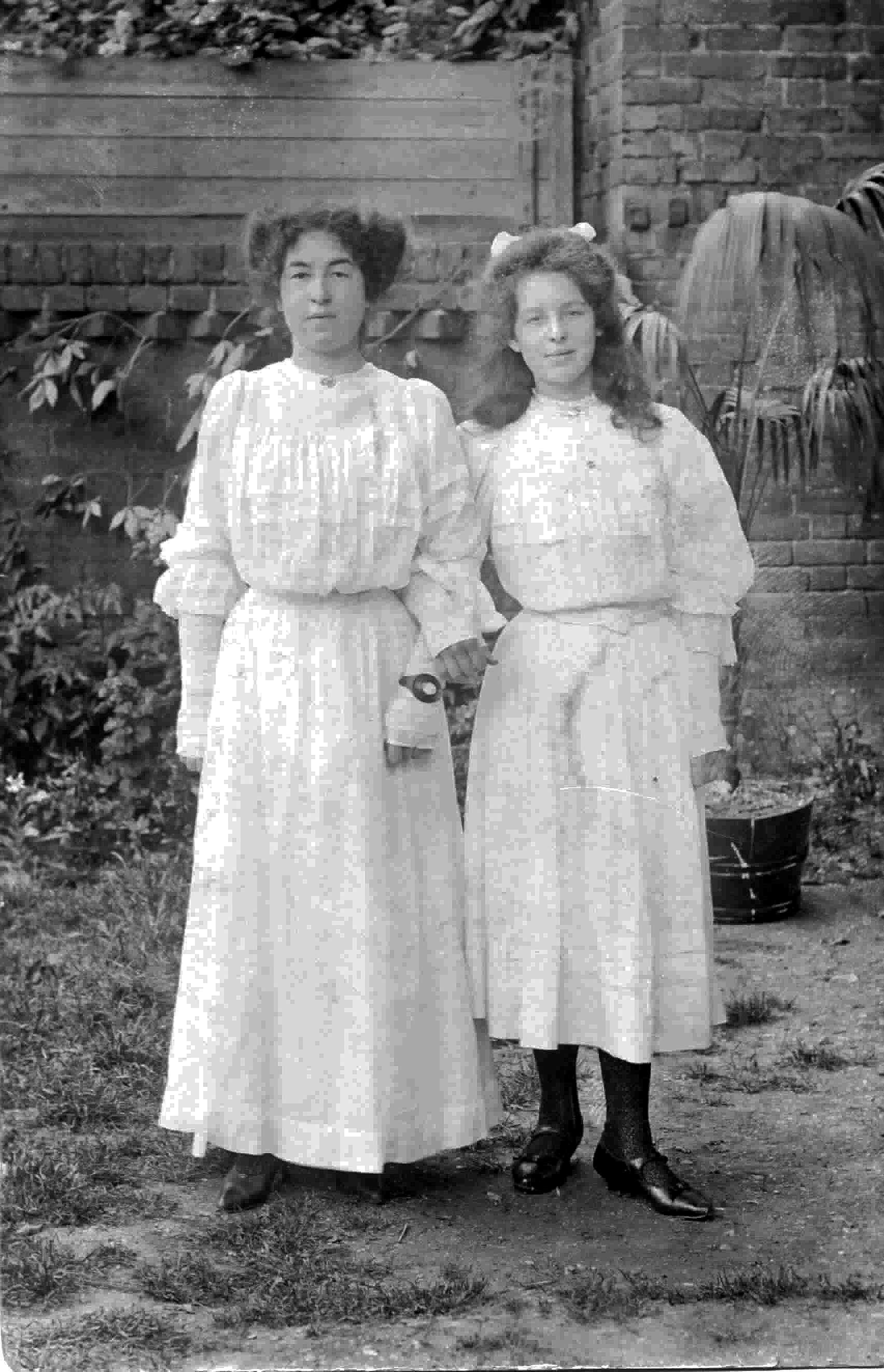 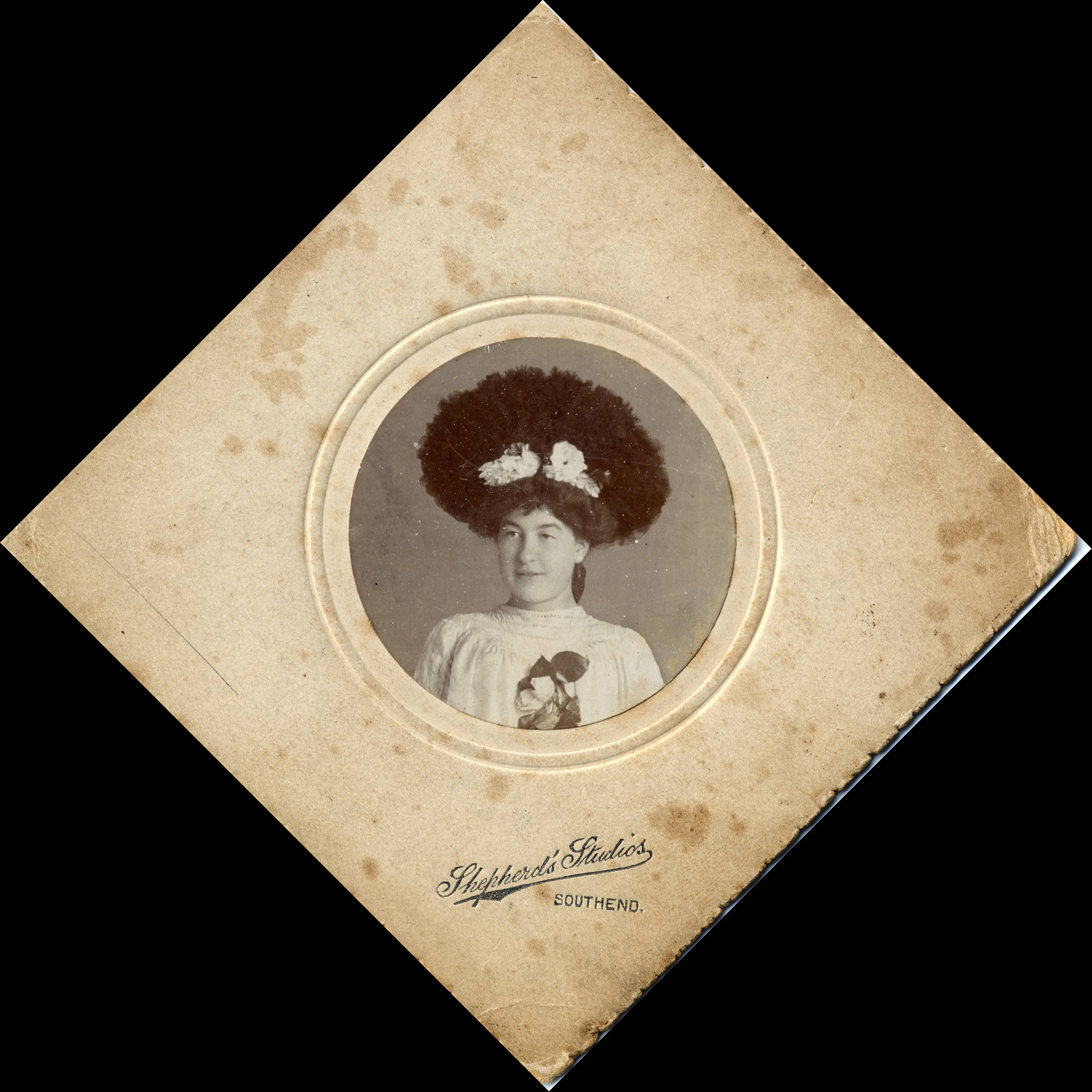 Emily Bertha and her sister Minnie Amelia Circa 1905 aged 17 and 11 ©Picture Michael Russell FIPD- 2003 Sisters: The pictures above are two of my favourites. My mother thought the first was taken at Wickford around the year 1905 when Emily and Minnie were dressed ready for church. So this is what Emily looked like when she first joined the Salvation Army. The second picture was taken at Sheppard's Studio's in Southend-on-Sea a bit later circa 1910. The girls all loved to sing and dance, something rather frowned upon by Catherine, but I suspect indulged by Arthur. We have Minnie Amelia above to thank for preservation of all the family pictures. 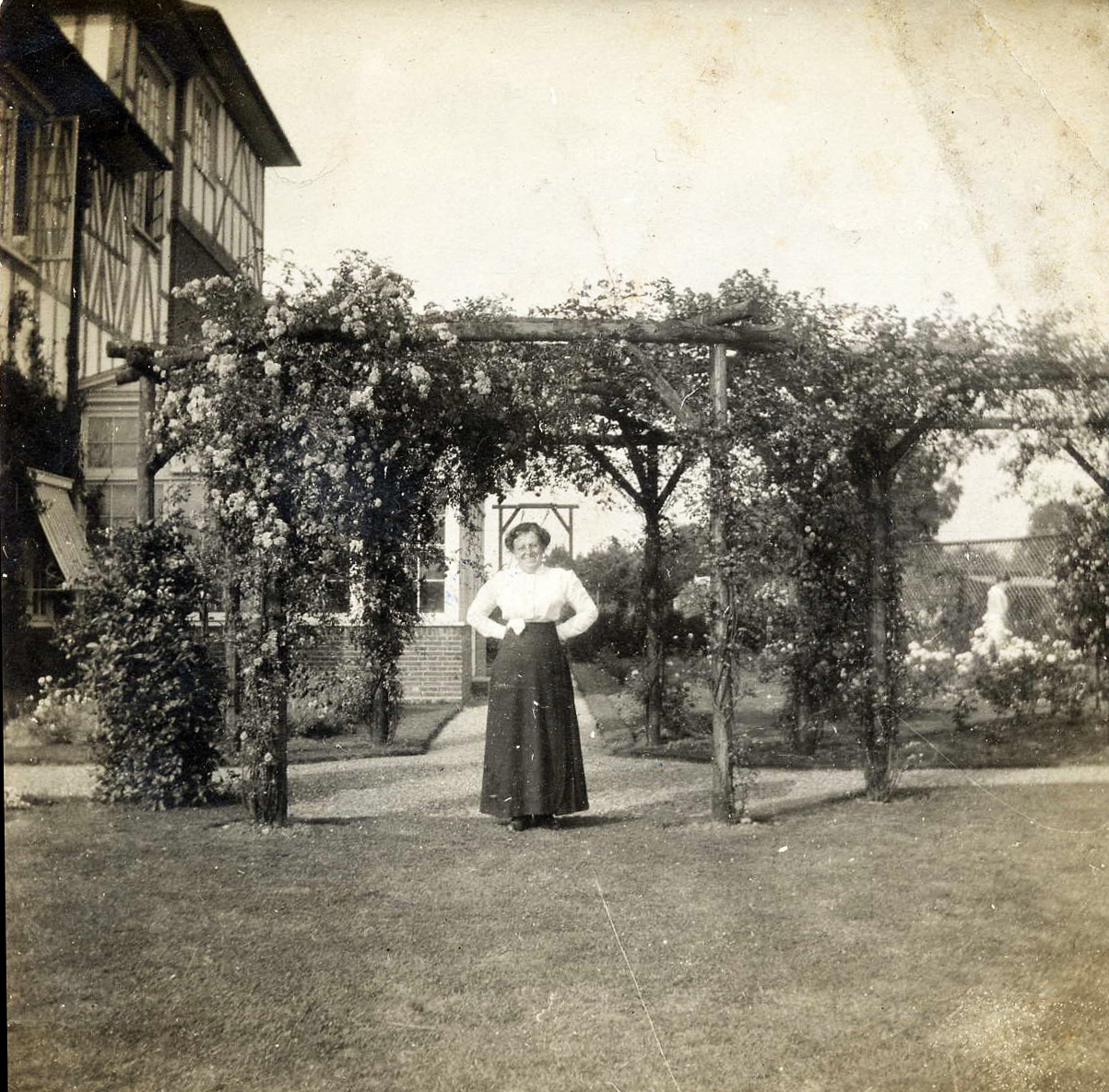 
Westcliff-on-Sea, Essex 1910-1912 Although Lilian Kate was the first of her sisters to marry in Wickford in 1907 it was the marriage of her eldest sister Florence Lizzie Christopher in 1910 which was to prove the most significant for Emily. Florence married a stone mason by trade called Victor Golding Thompson and they moved to live at Frederick Villas in Westcliff-on-Sea where they had a son in December 1910. As a seaside resort Southend-on-Sea with its attendant parishes of Westcliff-on-Sea and Chalkwell housed many Hotels and prestigious houses from which young ladies could obtain better paid domestic jobs. Emily soon gained employment there and is shown in the April 1911 Census as working as a domestic servant for a widowed bank clerk called John Herbert Gooch and his sister Eleanor. They lived at 41 Argyll Road in Westcliff where Emily looked after his 5 year old son. According to my mother Emily is supposed to have worked for a time with her younger sister Minnie Amelia for a rather well to do family, but I am not sure when or exactly where this was. These pictures are believed to have been taken at that house, and show some of it's gardens and the children that they helped look after. It is doubtful however that Emily herself ever lived there as at her own marriage in 1912 she gave her private address as 14 Argyll Road in Westcliff. According to my mother Emily's favourite pastime was dancing which she did regularly when she was in service and this was how she first met Percy around 1911. Although she remained close to all her sisters Florence was by then married with a young baby living in Westcliff and Lilian had moved to Leytonstone in 1907 with her husband who was stationmaster at Snarsbrook. Of her brothers, Arthur became a signalman at Brentwood, Frederick, and Jim (Robert James) were engineers working on Steam Engines at Stratford. So it was her youngest sister Minnie Amelia who accompanied her to the weekly 3 penny hop held at the bandstand on the seafront. Percy Nicholas McNally was the fifth of six children of Sergeant Major Henry McNally (1849-1887) and Clara Highwood (1850-1908) and been born in Kensington in London on 30th July 1885. He was a plasterer by trade and had been living in Shoeburyness since the turn of the century. Whilst the Christopher family were virtually all employed on the Railways his father, grandfather and great grandfather all served in the British Army. Amazingly there are no photographs of their wedding but we do have their marriage certificate.  Marriage Emily Bertha Christopher & Percy Nicholas McNally - 8th Apr 1912 ©Picture Michael Russell FIPD- 2003 There are lots of things wrong with this Certificate. The grooms full name was Percy Nicholas McNally, and in all census returns and within the family he was always known as Percy not Nicholas. His father was Sergeant Major Henry McNally of the Royal Artillery. Henry George McNally was actually his brother and was serving in the Border Regiment, not his father so clearly the certificate was not completed by any of the immediate family. The brides full name was Emily Bertha Christopher and she was employed as a servant although it was customary to omit any occupation for brides on certification. Emily's father was Arthur William Christopher and he was always known as Arthur not William. The church of St Paul, Westcliff-on-Sea (also known as St Paul's Reformed Church, Southend-on-Sea) originated in 1892 as an iron building on the corner of Summercourt Road (later Salisbury Avenue) and Eastwick Road. The iron church was later replaced by a permanent brick structure around the year 1903 and this was the building where Emily and Percy married in 1912. At that time St Paul's did not belong to the Anglican Church and was generally described as 'unattached', but seems to have been linked to the Free Church of England as it was often referred to as St Paul's Reformed Church. It's leader from it's foundation in 1892 was the Revd Alfred Waller (1865-1917) who performed Emily's marriage ceremony in the church and signed the certificate (4). Although we have no photographs of their wedding only 19 days later they attended the wedding of Percy's niece Dorothy Clara McNally (1889-1954) from which we have the photograph shown below. 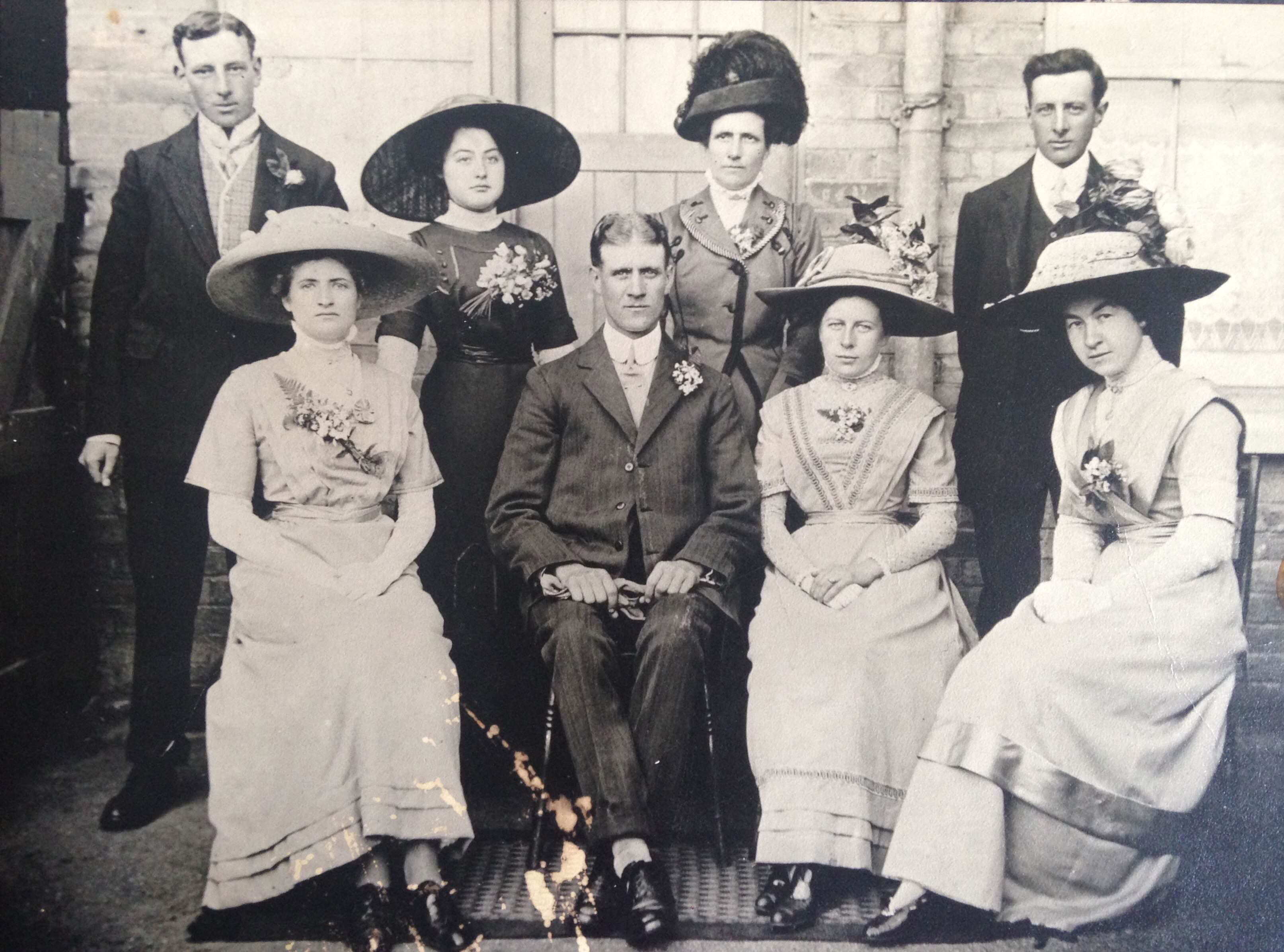 Marriage Dorothy McNally & William Gorrod - 27 Apr 1912 ©Picture Sally Ann Vince - 2016 William and Dorothy are obviously seated in the centre with my grandmother Emily seated on the right. They did not have much money when they married so I suspect that Emily is in her wedding dress of 19 days earlier. Standing behind her is Percy Nicholas McNally and standing far left his younger brother Thomas Edwin McNally (1886-1917) who was soon to be awarded the Distinguished Conduct Medal for bravery whilst under enemy fire in the First world war. He was killed at Flanders 5 years after this picture was taken and Dorothy was granted administration of his estate in 1919. According to my uncle Christopher McNally, Dolly whom he remained in close contact with, later pawned his medals so I suspect they passed out of the family. The others in the picture were from the Gorrod family. After marriage Emily and Percy returned to his parish of St Andrews in Shoeburyness to live at 53 West Road where they raised a family and remained for the rest of their lives. This was an end of terrace house which is still there as I write (2016) and situated not far from Shoeburyness Barracks, a major source of employment for the immediate area. Next door to the left at 55 West Road was Hooper's the hairdressers (5). I was cropped there as a young boy more than once. The house was accessed down a side passage and a front door that I never saw opened. Through a gate with a side trellis covered in honeysuckle, access was gained to the back yard where there was an external toilet (the only convenience) with a six inch gap top and bottom. I can tell you nobody hung about. After a large corrugated shed it opened out to a very pleasant garden where Percy grew all manner of bright flowers and at the very end was a chicken run supplying fresh eggs. There was a rear access to a pathway that ran behind all the houses in West Road down to St Andrews church and in which the local children gathered to play games. This was judged to be safer than playing in the street. Bath time was once a week in a large tin bath that was kept hanging on the back wall by the shed. It was brought into the back room and placed in front of the coal fire. It was filled to a couple of inches with buckets of cold water and then several kettles heated to produce a reasonable temperature. We then took turns, ladies first when we were banned to the front room otherwise only used on Sundays. My mother insists that early on in their relationship Emily made a pact with my grandfather that she would give up dancing if he would give up drinking. They both seem to have kept the promise although much later in life Percy was known to partake of the odd pint of pale ale, which he got from the off-licence across the road, and kept in a quart bottle in the sideboard cupboard in the front room. My mother remembered the squeak as he withdrew the cork late at night after he had put Emily, who by then was an invalid, to bed upstairs. 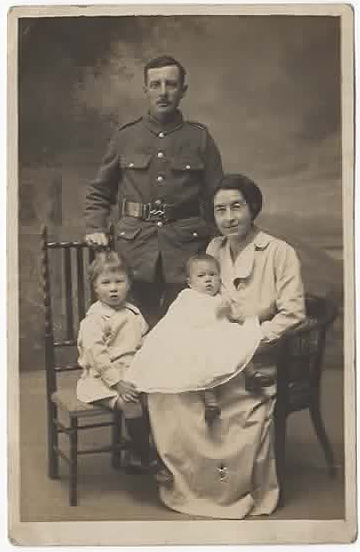 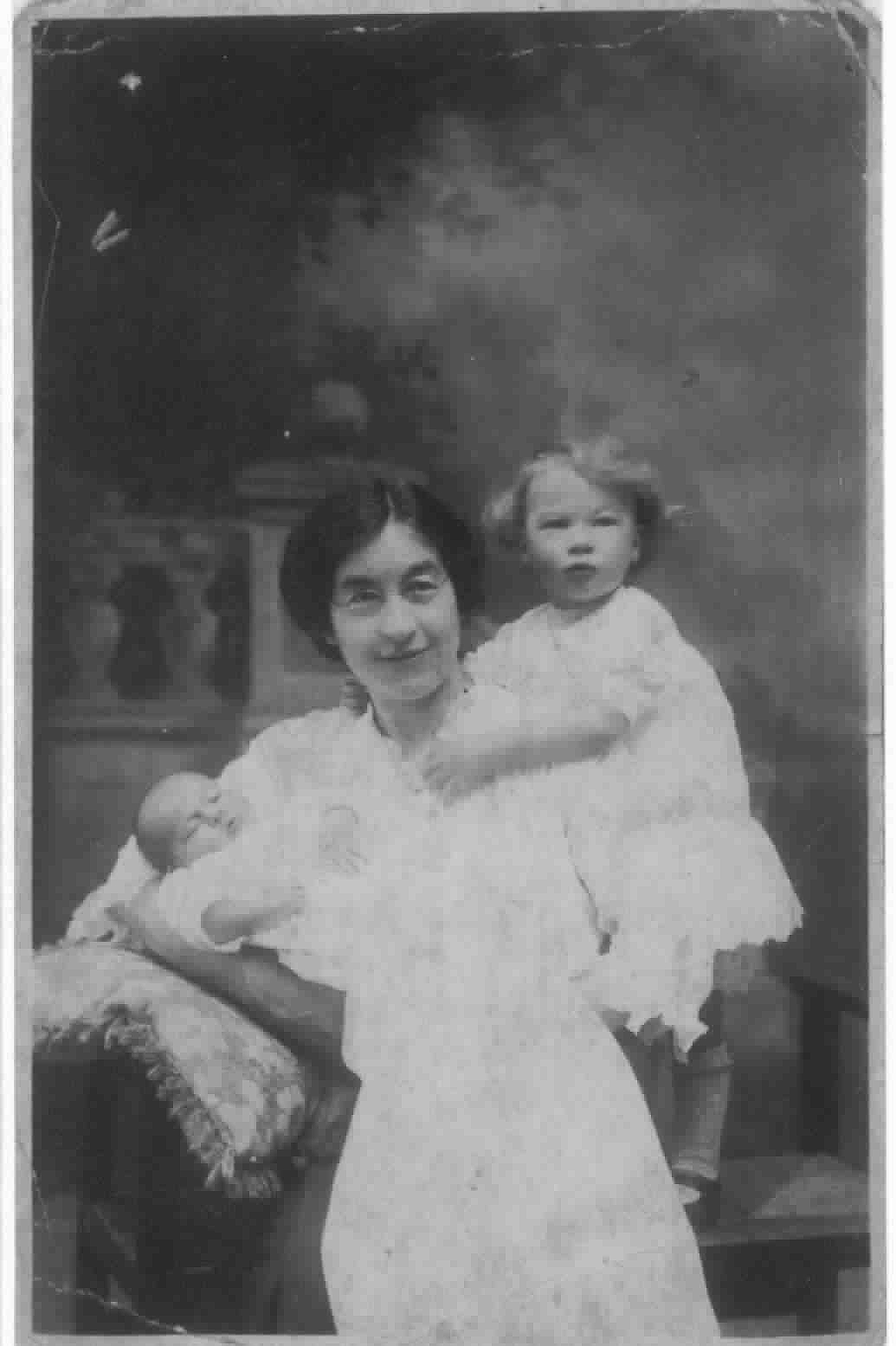 Children:- Emily and Percy had three children. Their first child was a son born a year later on 2nd May 1913. They used Emily's maiden name as his Christian name so he was baptised simply as Christopher McNally. Emily was soon pregnant again giving birth to their second child, a girl this time, on 6th August 1915 whom they called Edna (a popular name in the early 1900's) and Clara, in memory of Percy's mother who had died in 1908, to produce Edna Clara McNally . Edna was my mother and the picture left was taken at her Christening in the 1st week of September 1915. Emily is also holding my mothers brother Christopher aged 2 years and 4 months. Children:- Emily and Percy had three children. Their first child was a son born a year later on 2nd May 1913. They used Emily's maiden name as his Christian name so he was baptised simply as Christopher McNally. Emily was soon pregnant again giving birth to their second child, a girl this time, on 6th August 1915 whom they called Edna (a popular name in the early 1900's) and Clara, in memory of Percy's mother who had died in 1908, to produce Edna Clara McNally . Edna was my mother and the picture left was taken at her Christening in the 1st week of September 1915. Emily is also holding my mothers brother Christopher aged 2 years and 4 months. By now of course the First World War was well under way and the family had already suffered a severe blow when Percy's elder brother Lance Corporal Henry George McNally (1880-1914), a regular soldier with the Border Regiment was posted at the outbreak of war as part of the British Expeditionary force and killed at Ypres on 23rd Dec 1914. Percy's younger brother Thomas Edwin McNally (1886-1917) promptly enlisted in the 9th Division of the Royal Engineers, in the signal company, on the 9th May 1915. He was later to be awarded the DCM for bravery under enemy fire before being killed in Flanders in 1917. Emily having now given birth to their 2nd child, Percy also decided to join the Army in support of his brother attesting on 11th Dec 1915. His previous employer of many years was a Mr Sumner of Shoeburyness, now an officer in the Royal Engineers and being aware of his desire to join the Army and being married with 2 small children to support asked for him to be his batman. In all probability this saved his life. After training Percy was called for war service on 4th June 1916 and posted to Eppes in France with his Regiment. Back in Essex Emily's father died in September 1916 and her mother had to vacate the railway cottages at Wickford, so she moved to live at 69 Fleetwood Avenue in Westcliff-on-Sea not far from her daughter Florence. Link to views of some of postcards that Percy exchanged with his family in 1917 and pictures of some of the men he served with. At the end of the war Percy returned to England and was discharged from the Army on 29th April 1920. Having collected his British War and Victory Medals he returned to his family and went back to work for Mr Sumner. It was about this time that Emily developed the first signs of having contracted Parkinson's Disease. Little was known about the disease then and doctors initially thought that it was something that Percy had picked up in the trenches and subsequently infected Emily. They then suggested that they have another child as childbirth might purge her system. Whilst it is difficult to understand such diagnosis today there can be no doubt that the arrival of another son brought great joy to the household. He was born on 27th March 1927 and was named as Thomas Edwin McNally (1927-2010) in memory of Percy's brother of the same name killed in France ten years earlier. My mother helped to look after him from the outset, leaving school at the age of 12 so that Emily had support at home and Percy could go to work. Unfortunately the disease progressed rapidly and by the mid 1930's Emily had lost most of her mobility. The Great Depression: These were particularly hard times as emergency measures to try to deal with the great depression hit hard. By the end of 1930 unemployment had more than doubled from 1 million to two and a half and in the South East of England reached over 13.5%. In September 1931 an emergency budget immediately instituted a round of cuts in public spending and wages. Public sector wages and unemployment pay were both cut by 10% and income tax was raised which increased deflation and made things worse. Welfare then was not like it is today, it only paid out according to the level of contributions made rather than according to need, and was only payable for 15 weeks. As a result, like so many others, Percy was out of work for some time in the first half of that decade. Undaunted he took a practical step by taking an allotment and set about making the family largely self sufficient in food. Although a plasterer by trade he turned his hand to anything he could get and managed from time to time to get odd jobs working down the ranges at Shoeburyness for the Army. In 1936 the Government set about a progressive rearmament programme to combat the growing threat from Germany, and this increased jobs around Shoeburyness. My mother Edna was the first of the children to marry when she was 19 at the Rochford Registry Office on 29th November 1934. She married a Lance Bombardier in the Royal Artillery by the name of Cyril Frederick Russell (1910-1975). They continued to live locally in Shoeburyness until he was posted to India with The Regiment in 1937 and my mother and sister moved back into 53 West Road. They eventually joined him in India in January 1939 but after a short time had to return because of the outbreak of the Second World War. 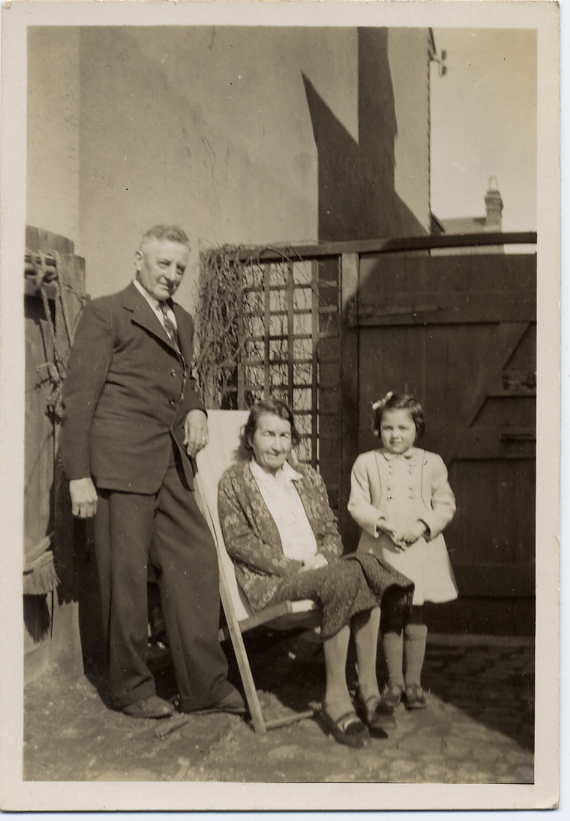 With the outbreak of the Second World War Shoeburyness took on extra significance. Not only was it the place the Army tested all it's new gunnery weapons but it was on the direct flight path between Germany and London. The Blitz officially started on 7th July 1940 and lasted until 21 May 1941. There was relatively little risk on the outward flight but any planes who had not managed to identify their London targets would look for secondary ones on the flight back, and the barracks was the last large target area before heading out to sea. Housing being close to the barracks clearly came into a high risk zone and pressure mounted for evacuation from Shoeburyness in June 1940. With the outbreak of the Second World War Shoeburyness took on extra significance. Not only was it the place the Army tested all it's new gunnery weapons but it was on the direct flight path between Germany and London. The Blitz officially started on 7th July 1940 and lasted until 21 May 1941. There was relatively little risk on the outward flight but any planes who had not managed to identify their London targets would look for secondary ones on the flight back, and the barracks was the last large target area before heading out to sea. Housing being close to the barracks clearly came into a high risk zone and pressure mounted for evacuation from Shoeburyness in June 1940. Evacuation: My mother took my sister and her younger brother Thomas Edwin Mc Nally to Torquay to stay with Cyril's mother Henrietta Lavinia Russell. Emily was evacuated to a nursing home in Guildford Surrey whilst Percy remained working on the ranges for the army and looked after the house in West Road. An air raid shelter was built in the garden but was damp and uncomfortable, and air raid warnings were so frequent that after a while many people ignored them. I can remember my mother saying that they just got under the thick mahogany dinning table in the living room until the planes had passed. The scale and intensity of bombing of London was unbelievable. London for example was bombed for 57 consecutive nights and a lot flew over Shoeburyness. Unfortunately on the afternoon of Sunday 18th August 1940 a bomb dropped into a garden 2 houses away killing a husband and wife living there. The explosion blew out all the windows in my grandfather’s house. Unfortunately on 13th February 1941 Henrietta Lavinia Russell died in Torquay of a heart attack leaving my mother not only looking after her young brother and my sister but cooking for the Russell family. Plymouth, which was only about 40 miles away, had already been bombed in July 1940 and was specifically targeted again by five large raids early in 1941 which reduced most of Plymouth to rubble. With my father stuck in the desert in North Africa my mother was very unhappy being away from her home and felt that with bombs falling in Devon as well she might as well go home. By 1942 not only was she settled back home but they had recovered Emily from Surrey and the picture left shows Percy, Emily and my sister Maureen back at 53 West Road. Behind the side gate with the trellis and honeysuckle growing over it is the passageway between my grandfathers house and Hooper's the barbers shop. At this stage Emily had been suffering from Parkinson's for 20 years and the affect on her health is clear to see. Six months after VE Day 1945 (which marked the end of the 2nd World War) Christopher Mc Nally married. He had been courting the daughter of a bookmaker called Frederick Charles Elliott for some time. She went by the rather impressive name of Louisa Valentina Elliott, but was better known to one and all as Lou. She had taken her name from her mother Louisa Agnes Digweed , had a younger sister called Ivy Ann and lived at 245 Fairfax Drive in Westcliffe-on-Sea. They were duly married in her parish church of St Mary’s in Prittlewell on 17th November 1945. Christopher was an avid sea fisherman and would often turn up with his days catch to share for tea. They had no children. In 1960 Percy had to go into Rochford General Hospital to have an operation on his bladder and this meant that Emily had to go in too as she was by now a complete invalid. Unfortunately she caught Bronchopneumonia and died on 27th January 1960. My father always insisted that it was the sudden change onto new drugs, the different diet and introduction of more rigorous exercise that was too much of a shock for someone over 70. Emily's death hit my grandfather hard and he came to stay with us after his operation until it was clear that he would be better off in his own home. My mother's younger brother Thomas Edwin was the last to marry at Rochford on 30th March 1963 to Sheila Frances Olive O'Carney. They were to have two sons David Thomas McNally in 1964 and Timothy Nicholas McNally in 1967. Percy Nicholas McNally died peacefully at the age of 81 at 56 West Road Shoeburyness in the chair that Emily had been confined to for most of her life on 14th March 1967. Genealogical Notes:- (1). 85 Arthingworth Street was to become the home of his parents Henry Christopher Junior (1838-1914) and Mary Ann nee Keys (1835-1914) from before 1911. When they died there in 1914 his uncles Ephesus Harry Christopher(1866-1944) and Frederick Charles Christopher (1868-1933) and his Aunt Alice Sarah Christopher continued to live in the house. Alice was still there in 1947. (2). The National School: The school was built by John Carter, carpenter, and George Carter, bricklayer, to the measurements of Mr Moss. The school cost £288 14s 11d to build. The main contributors to the cost were the Reverends Berens, De Tessier, Purvis and Lukin and their friends. Mrs Brewitt, of Bridge House Farm, David Archer, Thomas Bell and Henry Stone also contributed as did many other local people. The school was large enough for 75 pupils. Miss Eliza Flack, who had previously run her own school in the High Street in a room adjacent to John Salmon’s grocers shop near to Wickford bridge, was the first teacher. In 1886, when Mrs Catherine Douglas was mistress, only 50 pupils attended, on average, though in 1894 a classroom was added. (3). The Wickford Methodist Church on Southend Road was not established until 1927, well after they departed the village in 1916. The Methodists actually merged with the Congregational Church in 1970. (4). Alfred Waller ( 1865-1917) was born in Richmond Yorkshire. He is not an anglican minister so is not listed in Crockford's Clerical Directory nor in Surman’s biographical card index of Congregational ministers; He married Elizabeth Mary and had numerous children from as early as 1881. They had at least 4 children born in Southend. He later died on 9 November 1917, aged 62, and his ashes were interred under a memorial outside the church. Probate of his will was granted to his widow whom he left an estate of £2,590. 10s 11d (5). Hooper's the Hairdressers was run by Frederick William Hooper who died on 11th Dec 1948 |